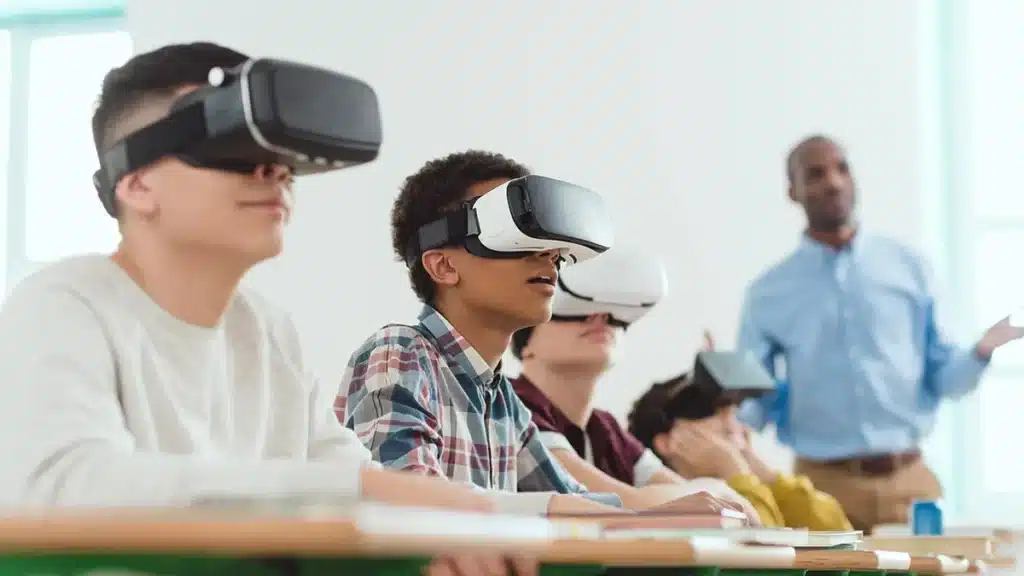XR Technology in Education The Future of Education
XR Technology in Education the use of extended reality (XR) technology is revolutionizing education in several areas. Virtual reality (VR), augmented reality (AR), and mixed reality (MR) are all included in XR. With the ability to offer students immersive learning experiences, remote collaboration opportunities, and practical training in a range of skills, each of these technologies has the potential to completely transform education.
Table of Contents

Immersion-based educational programs:
With the use of XR technology, educators can design immersive learning environments that let students interact, explore, and engage in previously unthinkable ways with virtual objects and scenarios. Students can use virtual reality (VR) to travel to different historical eras, explore the inside of the human body, or visit isolated locations all over the world. With augmented reality (AR), digital content can be superimposed on the actual environment. For example, students can be given interactive labels for scientific specimens or task instructions. MR creates a hybrid environment where digital and physical objects coexist by combining AR and VR. This can be used to make lifelike training simulations or to give students first-hand experience with objects that would be risky or difficult to handle in the real world.
distant cooperation:
Teachers and students can collaborate remotely with the help of XR technology. Students can collaborate on group projects or take part in virtual field trips using virtual reality, for instance. Instructors can use augmented reality (AR) to give students instant feedback on their work or to take them on a virtual tour of a lab or classroom.
Simulation and training of skills:
XR Technology in Education The Future of Education: With the use of XR technology, students can receive practical instruction in a range of subjects. Engineering students, for instance, can design and test prototypes in virtual reality before constructing them in the real world. Before executing complicated procedures on patients, surgeons can practice them in virtual reality. VR can also be used by pilots to train in flight simulators.
XR technology has the potential to improve student motivation and engagement. When they are actively involved in the process, students are frequently more interested in what they are learning. Students can learn through experimentation, exploration, and discovery with the help of XR technology.
Studies have indicated that students learn best through doing. XR technology can give students practical learning opportunities that will improve their comprehension and memory of the material.
With the use of XR technology, students can gain access to knowledge that they would not otherwise have. Students can use virtual reality (VR) to visit museums and other cultural sites across the world or to take part in lectures given by prominent experts in their field.
overcoming the divide between theory and reality
XR Technology in Education The Future of Education: XR technology gives students the chance to apply what they have learned in the classroom to real-world scenarios, which can help close the knowledge gap between theory and practice. Students can practice doing medical procedures or designing new products, for instance, by using virtual reality.
In summary XR Technology in Education The Future of Education
Although XR technology is still in its infancy, it has the power to completely transform education. We should anticipate seeing an increasing amount of XR technology utilized in classrooms worldwide as it gets more widely available and reasonably priced.
Here are some instances of how XR technology is currently being applied in the classroom:
XR Technology in Education The Future of Education: By giving students the opportunity to visit various locations and eras firsthand, virtual reality is being utilized to educate students about science, history, and other subjects. Students can visit ancient Rome, investigate the solar system, or study the human body using virtual reality, for instance.
Students are getting interactive learning experiences thanks to augmented reality. Students can use augmented reality (AR) to practice arithmetic problems, see how chemical reactions work, and learn about various plant and animal species.
Realistic simulations are made with MR and used for training. For instance, MR is being used in the training of firefighters, pilots, and surgeons.
XR Technology in Education The Future of Education: With the use of XR technology, education could become more successful, inclusive, and engaging for all students.


